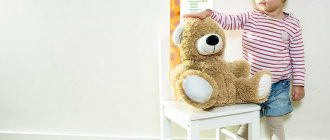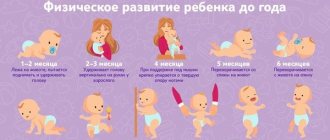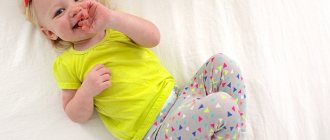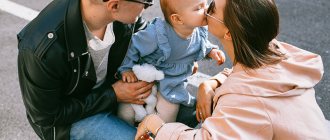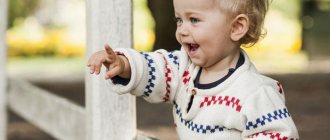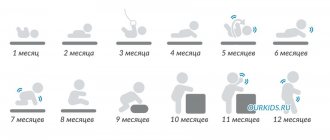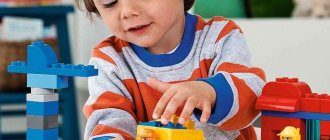What should a 2 month old baby be able to do?
Children of this age must have a certain set of motor-sensory, social and intellectual skills.
| № | Skill category | What achievements and knowledge should be |
| 1. | Motor-sensory |
|
| 2. | Social |
|
| 3. | Intelligent |
|
If you communicate or play with a two-month-old baby, he will be active for a longer period of time, since at this age he begins to show more attention to people than to objects.
Child development. New opportunities, new prospects - baby 2-3 months old
Choosing toys
- To stimulate motor activity, the baby will need a large, bright toy; it would be good if it also had sound. The “classic” version of such a toy is the tumbler
. - At this age, children can spend a long time looking at bright towels, colorful scarves, etc. attached to the side of the crib or the wall of the playpen. (and in the future, turn your whole body towards them and try to grab them). You can attach a special “developmental” mat
: such mats with hanging mirrors, toys, ribbons, “squeakers”, etc. are sold in children's goods stores. Some models of such rugs are designed to grow and can be transformed as the baby’s abilities and interests change, so your child will be able to play with them when he gets older. However, we must remember that the rug, scarf or towel must be securely attached to the side of the crib or playpen so that the baby does not get entangled in them. - Particular attention will have to be paid to the choice of rattles
, because now your baby will not only look at them, but also hold them in his hand, so a rattle for a 2.5 - 3 month old child should have a comfortable handle. It is best if it has the shape of a straight rod with a rounded end. It is good if the rattle is made of a material that is soft and warm to the touch: according to experts, it is such materials that stimulate cognitive activity, while toys that are hard and cold to the touch frighten babies. And finally, there should be no doubt about the harmlessness of the material from which the toy is made. - “Research material” for a child can be not only toys, but also household items
: offer him (but only under the supervision of an adult!) a painted wooden spoon with a rounded handle, a pom-pom made of thread, a whisk for whipping. - To diversify a child’s tactile sensations, you can sew toys or (if you don’t have time) bags from bright fabric, filling them with “fillings” that feel different to the touch: washed river sand, peas, feathers, straw, etc. Ready-made toys are now available for sale of such kind. For example, a soft cube, all sides of which are sewn from different materials (satin, fur, terry cloth, etc.), or a cow stuffed with plastic balls. You can stuff ready-made soft toys with this material. It is better if the bags or toys are small and oblong in shape - then it will be more convenient for the baby to hold them in his hand. It is also necessary to ensure that the fabric from which they are made does not fade, is dense and durable, and that the seams are well sealed - after all, the first thing a little researcher will do is try to taste the “research objects”. It is desirable that the fabric from which different bags or toys will be sewn be different in texture. You can simply offer your child scraps of fabric of different colors and textures, no more than 20 cm long (the edges need to be trimmed).
Previously, in Russian villages, rattles were made from “environmentally friendly,” durable and “warm” materials: wood, birch bark, bast, bone (sometimes the same bone horns from which babies were fed were used as rattles, putting peas in them and sealing the hole) . Even such unusual materials as pet bladders and dried bird necks were used. Such toys were difficult to break, and the baby could taste them without harm. In addition, small children were often given ordinary household items to play with and “study”: “bread” spoons, bast shoes, wooden Easter eggs, boxes - and not only because they had few specially made toys, but also in order to the baby became familiar with the world in which he was to live as early as possible. |
Learning to control your body
- Around 4 months, the baby begins to learn to turn on his side on his own. To help your baby, place a tumbler in the crib or playpen next to the baby lying on his back. The same role as the tumbler can be played by a bright scarf, rug, or simply a large piece of patterned fabric hung on the side of the crib or the wall of the playpen. Babies are especially attracted to fabrics with contrasting patterns.
- Try to set a more “distant” goal for your child: place the toy at a distance so that it is not so easy to reach it. In this case, the child will also want to reach it and will first turn to it, and then reach out and even try to crawl. After several such attempts, move the toy towards the child.
- When showing your baby a toy, walk around the crib or playpen with it so that the child turns around, following the toy with his eyes.
- Tie a bell on a ribbon to the baby's arm or leg or attach a special rattle with Velcro - this will not only give the baby great pleasure, but will also help him learn to feel his body. There are also “musical socks” on sale, in which a small rattle is inserted, but a similar thing can be made independently by firmly sewing bells to ordinary socks.
Developing fine motor skills
Grasping objects and holding them in your hand is by no means an easy task for a two- to three-month-old baby. To help your baby learn this, offer him a new version of the game with a rattle. 1
(instead of a rattle, you can use a painted wooden spoon with a rounded handle):
- Show the child a rattle, rattle it, move it from side to side; when the baby reaches out his hand to the toy, help him: place the rattle in his palm. If the child at first cannot hold the rattle and immediately drops it, pick it up and give it to him again. The game will become more interesting for the baby if you offer him rattles each time, different in color and shape (but do not forget that they must have a handle that is easy to grip.)
- When the baby learns to hold a rattle in his hand for a sufficiently long time, complicate the game by changing the shape of the object being grasped: put the baby on his stomach, and in front of him place a small (but in no case less than 3 cm in diameter!) bright round object (this can be, for example, a ring from a pyramid or a figurine from a plastic Lego constructor designed for the little ones). When the child grabs it and tries to bring it to his mouth, take the ring from him and put it in front of him again. Then replace the small ring with a larger ring. This game will help your baby learn to grasp objects of different sizes in his hand.
- Continue to complicate the game by offering your baby two rings at the same time - a large one and a small one. In the future, introduce objects of a different shape into the game, placing in front of the baby blocks from the same “Lego” with large parts, soft toys or bags with “fillings” that feel different to the touch (see their description above), etc. Thanks to this game, not only motor skills develop, but also touch.
Invite your child to take toys from different positions: lying on his back, sitting in the arms of an adult, etc. Try giving him two toys at the same time.
The tumbler appeared in Russia not so long ago - less than 200 years ago. Historians believe that it came to us from Japan. The prototype of this toy was the hermit monk Dharma (the Japanese called him Daruma) who lived in the 6th century AD, who brought the teachings of Zen Buddhism and tea from his native India to China and Japan. According to legend, Daruma devoted himself to prayer and meditation for nine years, as a result of which he came to enlightenment. All this time he sat facing the wall of his cave, without moving or even blinking. From sitting for a long time, the monk’s arms and legs withered, so the Japanese tumbler, which is called “daruma,” has no arms and legs. She is dressed in traditional red robes for Buddhist clergy (remember the traditional red outfit of our tumblers!). Daruma is usually made from wood or papier-mâché. In Japan, daruma is taken very seriously. It is believed that this toy brings good luck to people who are persistent in achieving their goals. On New Year's Day, every Japanese buys a daruma figurine that has no eyes on its face. You are supposed to draw one eye on the daruma and at the same time make a wish. If the wish comes true, then the owner of the daruma “rewards” him with a second eye, and if not, the daruma remains with one eye until the next New Year, after which it is burned during a special ceremony. The first Russian wooden tumblers, which appeared at fairs in the early 19th century, were called “somersaults”; At first it was merchants, clowns and girls on the ball. |
Learning to listen and speak
It is believed that learning to perceive the rhythm and timbre of sound helps the baby master speech. Therefore, small “musical activities” not only bring pleasure to the child, but also contribute to his development.
- Let your child listen to a recording of the same melody performed on different musical instruments (if you yourself studied music, you can perform the melody yourself - for example, on a harmonica, a children's pipe, a metallophone). You can hum a melody that your baby heard performed instrumentally. It should be borne in mind that the melody should be simple, easy to remember and its range should not exceed one octave.
- Take your baby in your arms and dance with him to the music. Try doing gymnastics to music.
At 3-4 months, your child begins to “talk” not just like that, but purposefully: with his “speech” he wants to attract your attention. Try to make your communication more fruitful.
- Teach your child to imitate your speech. To do this, first repeat his “favorite” sound several times yourself (by listening carefully to his “monologues”, you can easily identify it). After a while, the baby will begin to repeat this sound after you. Then introduce new sounds into the “roll call” (preferably vowels at first). Thanks to such “dialogues,” the baby’s articulation skills will improve.
- When talking to a child, even the smallest one who seemingly “doesn’t understand anything,” never lisp or distort words.
- When you feed and dress your child or play with him, try to talk to him not about extraneous topics, but about what you are doing at the moment. At the same time, repeat the so-called “key” or main words more often: the names of parts of the child’s body and items of clothing, dishes and toys. In this case, it will be easier for the baby to remember the sound and meaning of these words.
1 Games with rattles for children 1 and 2 months old, see my articles “Child Development. Games and toys: month one”, No. 9/2001 and “Child development. Games and toys: month two", No. 10/2001. |
What should parents of a two-month-old baby be wary of?
Each baby is individual and has its own characteristics of mental and physical development. However, there are a number of specific skills that every two-month-old baby should have. If the baby is of this age:
- does not smile in response to a face seen or a voice heard;
- does not visually focus on a stopped or moving object;
- does not grab onto parts of the body;
- does not hold basic objects in his hands;
- does not hold the head for several seconds;
- does not listen to the voices of adults;
- does not make any sounds;
- does not react to the source of sound, does not look for it with the eyes;
- does not roll over from side to back;
- does not show a “revival complex” in response to communication –
Parents should consult their pediatrician. Only a doctor, after examination and additional examination, will be able to determine whether the lack of the above skills is a manifestation of a pathological process or an individual feature of the baby’s development.
Many parents mistakenly believe that children in the first months after birth should only sleep, eat and not show any activity or any emotions or sounds. A healthy child of 2 months should actively play with adults, and also persistently, cheerfully and loudly cry about his needs (changing clothes, sleeping, eating). Prolonged sleep (more than 7-8 hours) and rare crying of a two-month-old baby should alert adults. This may be a sign of weakness and lack of strength in the child. In such a case, you need to contact a specialist.
It is also necessary to show the baby to a neurologist and pediatrician if the child cries for a long time (at the same time his chin and arms begin to tremble), sleeps little, burps frequently and a lot, or throws his head back.
Wellness and treatment
At 2 months you will need to visit a pediatrician.
The specialist will conduct a full preventative examination. Medical examination at the age of 2 months is not provided. If parents follow the schedule of the National Vaccination Calendar, then at two months the pediatrician will send Prevenar 13 (pneumococcal vaccine) for vaccination and you need to prepare for DPT and polio vaccination, which will be given in a month.
A visit to an orthopedic traumatologist is also planned for next month.
At 2 months, the baby may be bothered by intestinal colic, as well as excessive regurgitation. The digestive system is just developing, so many parents face such problems. Sometimes a reason for concern can be an increase in body temperature.
You can ask questions about the development of a 2-month-old child and his care to competent specialists by contacting a medical specialist.
Nutrition for a two month old baby
For good health and full development of the baby, you need to try to breastfeed him. Breast milk is well digestible and rich in all micronutrients and vitamins necessary for growth and development. Breast milk also contains antibodies - immunocompetent cells that enhance immunity and protect the baby from various pathogenic bacteria.
The baby’s stomach is sensitive to the quality of food, so children who are bottle-fed need to choose formulas adapted to their body and as similar in composition as breast milk. To choose the right baby food, it is better to consult a pediatrician.
In the second month of life, the baby's digestive organs improve, so children may be bothered by intestinal colic. Special medications (as prescribed by a doctor), folk remedies (dill water, warm diaper), physical exercise and dietary compliance by the nursing mother will help reduce their manifestations.
It is recommended to feed a two-month-old baby every 3-3.5 hours (including at night). According to most pediatricians, breastfed children should be given breastfeeding on demand. To avoid overeating and frequent regurgitation, you should still adhere to a certain feeding regimen, for example, with an interval of 2-2.5 hours.
In order for a child to gain weight correctly, develop and grow, he must eat the daily dose required for his age - ⅕ of his weight. On average it is 700-900 mg per day.
The child distributes the required amount independently in a chaotic manner. For example, during one feeding he can eat 25 mg, during another - 130. That is why control weighing (determining the child’s weight before and after eating) does not provide objective information. To find out how much a baby actually eats per day, you need to weigh him at each feeding. However, this is a rather inconvenient and expensive method (buying scales).
There is a more objective and handy method. This is the determination of the number of daily urinations using disposable diapers. In this case, diapers must be abandoned. If a child urinates 10-12 times a day, this is normal and he does not suffer from milk deficiency. If the number of urinations is less, you should consult a doctor who will determine the cause of underweight and insufficient urination, and also provide recommendations regarding the organization of the feeding process.
Vision
At 2.5 months, a child’s visual skills have noticeably improved, thanks to which he can not only see, but also analyze what he sees. Notice how your son or daughter carefully looks at your facial expression, examines unfamiliar objects, and monitors the changes in the position of toys and other things.
What should a 2.5 month old child be able to do? The baby must not only carefully observe the world around him, but also hear all the sounds. This is very easy to check: just look to see if he turns his head in the direction in which the loud sound was just heard. Bells, rattles and other sounding toys promote the active development of the auditory organs. Avoid toys with loud sounds, and when communicating, make sure your voice is calm and not too loud.
2 month old baby's daily routine
At this age, the child does not yet have an individual routine. A two-month-old baby's daily routine is built around feedings. There should be an average of 5-8 of them per day. Of these, 2-3 feedings are allocated for night meals. You need to try to ensure that the child eats and sleeps at the same time. It is also recommended to maintain intervals between sleep and feeding.
During the day, a two-month-old baby sleeps on average 4-5 times (usually after each feeding). Sleep duration is 1-1.5 hours. During the day you need to go outside with your child (2 times for 1.5-2 hours), do gymnastics, air baths and work on his development.
Methods and directions of development of two-month-old children
The development of a child, even from 2 to 3 months, should not be left to chance. Yes, the baby will grow up at his own pace, but improper handling of the baby during the period of the most active learning of new things can slow down natural processes.
This is not about training as such; parents are only required to help develop the physical, emotional, and psychological skills of the newborn at a moderate pace. There are several ways to do this, but classes should be systematic, every day, not for long and at approximately the same time.
Lying on your tummy
This sensory activity is an essential part of a child's daily life. By placing him on his stomach for a few minutes, the baby develops better coordination of movements and trains the muscles of the neck, shoulders, arms and spine. At the same time, the baby later learns to roll, pull up, crawl and sit.
Reading
Of course, reading or even understanding what is read is not something a person with the development of a 2-month-old child should be able to do.
But the baby needs to read aloud so that he:
- getting used to my parents' voice;
- heard correct speech;
- learned to listen (in such moments, babies are quite attentive);
- received the makings of language development;
- developed memory;
- strengthened the connection with mom and dad.
You should not start reading when there is extraneous noise, as the baby’s attention should be focused on you. Use intonation and facial expressions, but don’t get carried away - babies quickly get tired, lose interest and begin to be capricious. Literally five minutes is enough.
Touch
Sensory activities should also be considered.
What kind of touch should be:
- skin touches skin - not through clothing;
- slow rocking and hugging;
- stroking all over the body, including arms and legs;
- massages (only after consultation with a specialist; incorrect manipulations can cause great harm).
Thanks to these simple exercises, the child-parent connection is established, psychological and physical health is strengthened, sleep improves, and temperature and heart rate are stabilized.
Movements with a child
Movement should be an integral part of the life and development of a 2-month-old child. They train the vestibular apparatus. The purpose of such exercises is not to force the baby to move, but to move with him, for example, dancing to music with him in your arms. You can simply slowly swing the baby in different directions, changing the speed of movement in the air. But every minute you need to pause, fix the body and make sure that the child does not get too excited emotionally.
Finger games
A baby's vision at the age of 8 weeks is not yet sufficiently developed, and he does not see very well. At the same time, he likes to watch moving objects, including fingers. It is not necessary to buy or sew special toys for the game (although this is also an interesting option - a puppet show), you can simply move your hands rhythmically to the music or your stories, lower your fingers down and raise them up, move them from side to side at different tempos, imitate the movement "worm".
This also includes exercises with the baby’s fingers - touch them, bend them (you can read rhymes), let’s touch things with different surfaces, for example, fabrics and knitting.
Observation of an object
At the age of two, the baby sees at a distance of 45 cm from his face, can maintain attention on a separate object and follow it for a short time. This skill can be developed through play.
Choose an object or toy that your baby is interested in and hold it in front of his face. When you see that the baby is looking at it, begin to slowly move it in different directions. It is very good if the game is accompanied by your conversations, sound effects or a song.
Do not forget to develop your observation skills - if the child does not show any interest in games and exercises, do not force him. Perhaps he is not ready for them yet and needs to try in a week or two. It all depends on the individual growth characteristics of each child.
It’s worth trying special sets (The World in the Palm of your Hand or We Speak from the Diaper), which develop attentiveness and concentration.
Increase in height and weight during the second month
During the first month, a newborn male baby can gain 400–1200 g, a female baby about 400–900 g. During the second month, the gain can be more significant: 400–1500 g for boys and approximately 400–1300 g for girls. The acceleration of weight gain is due to the fact that the baby is strong enough and eats more actively. In the third month, the baby can gain 100 - 300 g less than in the second, as it begins to show motor activity.
Good to know! Over the course of a week, a boy gains approximately 160-220 g, and a girl – 140-200 g.
In the first months of life, the child grows actively; the length of his body can increase by 3-3.5 cm in the first 30 days. The growth will be approximately the same during the second month. For the third month, these rates will continue, and then the baby will grow by an average of 2-2.5 cm per month.
Fitball exercises for infants
It is important to develop the baby physically. Exercises with a 2-month-old child on a fitball are useful. Gymnastics helps reduce hypertension, strengthen muscles and joints. Also, exercises on the ball reduce colic, which affects all babies due to immature intestines.
Also, exercising on a fitball trains the vestibular apparatus, improves the functioning of the kidneys and liver, relieves spasms, strengthens the spine, and makes it more flexible.
Physical activity has a positive effect on the nervous system. To get the maximum benefit for your baby from exercising on a fitball, you need to do it correctly. The ball should be chosen with a diameter of 60-70 cm.
Its surface should be smooth so as not to damage the delicate skin of the baby. A fitball can also be useful for mothers to recover after childbirth.
A high-quality gymnastic ball must meet the following requirements:
- have no odor;
- be made of durable, environmentally friendly rubber;
- do not have convex connecting seams;
- be elastic.
Training program on a gymnastic ball for two-month-old children:
- put the child on the fitball with his stomach. Holding the baby by the back and legs, begin to rock the ball back and forth;
- turn the baby onto his back and continue rocking;
- lay the baby on his side. Holding it by the shin and forearm, rock the fitball back and forth;
- put the baby on his back. Hold his chest with both hands. Move the ball clockwise or counterclockwise.
Fitball exercises should be carried out in the first half of the day, when the baby has slept and is in a good mood.
Gymnastics is contraindicated in the following cases:
- spinal injury;
- painful condition;
- the baby is in a bad mood.
Before each use, the ball must be washed with soap. To make the lesson more interesting, you should conduct it with children's music. You can also recite rhymes, nursery rhymes, and sing songs. There are other exercises on a fitball for children. Before performing them at home, it is recommended to consult a specialist and watch a training video.
